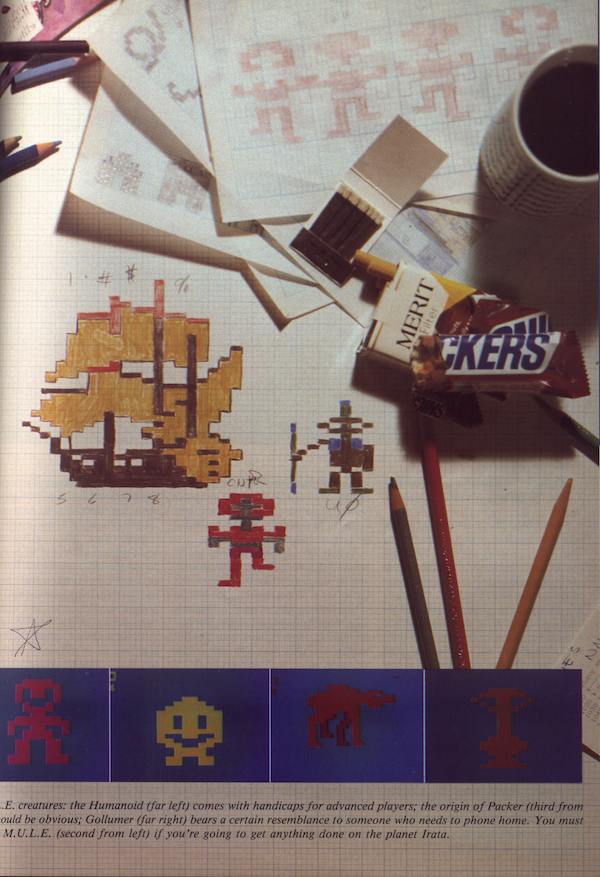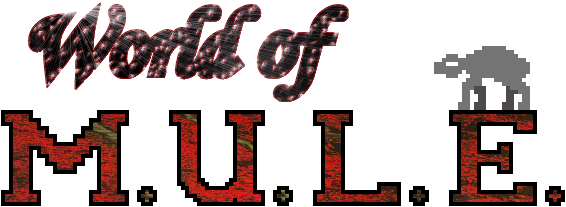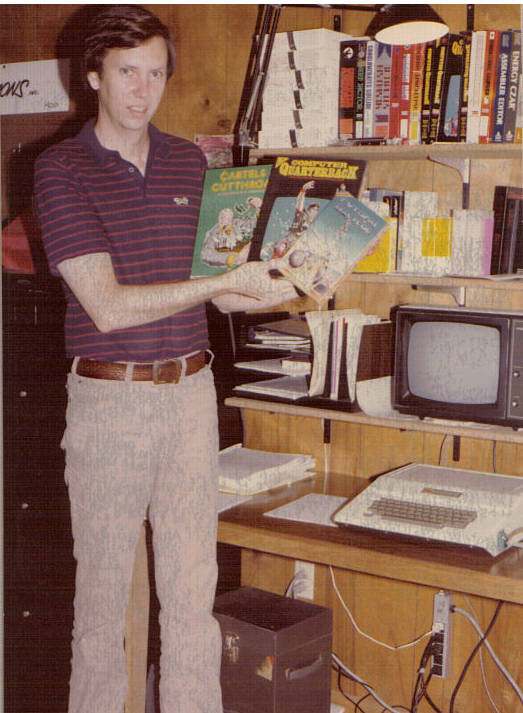- Source: This is a copy of the original article on the Arkansas Times website, published February 8th 2012. Please also visit his original site, because the comments below the article (not replicated here) are just as interesting to read as David Koon’s article itself. Thanks David for such an excellent contribution to the M.U.L.E. legacy!
- original source last checked working in February 2019
If you’ve never heard the names Dan Bunten or Dani Bunten Berry (the name Dan Bunten took following gender-reassignment surgery in November 1992, after which she added her mother’s maiden name), you can be forgiven. Though Dani Bunten is one of the most celebrated pioneers of the multi-billion-dollar video game industry — a Little Rock designer whose theories about the social appeal and cultural promise of gaming have been proven correct again and again since her death in 1998 at just 49 years old — the American memory is particularly short when it comes to the medium of video games. While old films like “Casablanca” and “North by Northwest” will probably screen as long as mankind has access to electricity and a white wall to project them on, gamers’ respect for individual video games tends to bloom and fade as quickly as young love. Other than a few beloved titles like the original Super Mario Brothers and Pac Man, video games usually fascinate the public imagination exactly as long as it takes for the next flashy system or groundbreaking title to come along. After that, most games quickly retreat to the bargain bin before disappearing down the memory hole, and usually take the names of their creators down the hole with them.
It is a measure of Dani Bunten’s genius and enduring legacy, then, that Bunten is still considered something of a rock star among game designers and those interested in the history of games. For Bunten, an engineer who grew up loving family board games like Risk and Monopoly, the social aspect of gaming was the thing, as was the belief that a human opponent was always going to present more challenge and fun than even the best computer brain. That fueled Bunten’s passion for multiplayer games at a time when the technology for making multi-play happen was so primitive that almost no one else in the field saw a future in it.
With the continued rise of the Internet and online gaming since Bunten’s death, however, that message looks more and more prophetic as the years go by, leading her to be more revered than ever in certain circles. Though 14 years (and several quantum leaps in graphics and gameplay) have passed since Bunten died, hundreds visit “The World of M.U.L.E.” webpage every week to discuss and reminisce about the most influential game created by Bunten’s Little Rock design house, Ozark Softscape. Vintage copies of Ozark Softscape games, even those for long-defunct systems, routinely sell for many times their original price on eBay. Celebrity game designer Will Wright dedicated “The Sims” — still the best selling PC game of all time — to Bunten. When PC World Magazine named the 10 greatest PC games ever in 2009, Ozark Softscape’s “M.U.L.E.” — which they called a “strategic masterpiece” — landed at number five. EA Games, the gaming goliath that Ozark Softscape helped get off the ground with its groundbreaking outer-space-mining title “M.U.L.E.,” raked in $3.8 billion dollars last year, and today, Bunten is enshrined in almost every Hall of Fame and museum created so far to celebrate video game design, and won a 1998 Lifetime Achievement Award by The Computer Game Developers Association. She was posthumously inducted into the Academy of Interactive Arts and Sciences Hall of Fame 2007, and a permanent archive of her personal papers at the International Center for the History of Video Games resides at the Strong Museum in Rochester, N.Y.
While selecting pronouns is difficult in any recounting of Dani Bunten’s story, Bunten throws a long shadow in the gaming world, and it’s getting longer every time a kid picks up a controller for the first time.
The list of video game firsts or near-firsts that Dani Bunten managed to fit into one tragically abbreviated lifetime would still be impressive even if that life had been twice as long. Bunten’s first game, 1978’s “Wheeler Dealers,” was the first personal computer game that was packaged in a printed box, and one of the first — if not the first — computer games that allowed for more than two players (the game shipped with four custom-built controllers made from red wooden macrame beads with a single button glued into one end, which players used to make stock-market-like trades while competing against one another). In a game development memoir on Bunten’s now-offline personal website, the designer said that a word processor program written to create the instruction manual for “Wheeler Dealers” came “within a hair’s breadth” of being chosen to be the “Apple Writer” software shipped with some of the first Apple computers (“Being rich was never my goal,” Bunten wrote of the near miss, “but it would have been nice .”)
“Seven Cities of Gold,” an Ozark Softscape title produced for EA in 1984 that eventually became the best-selling game of Bunten’s career, was one of the first video games to take a stab at an “open world” concept, allowing players to explore a virtual continent and set their own path rather than follow a regimented series of events. That makes it one of the granddaddies of all modern free-roam games, including “World of Warcraft” and the “Grand Theft Auto” series. Based on the Spanish conquest of the New World, “Seven Cities of Gold” was also one of the first games based on historical events instead of a fantasy or science-fiction plot, which makes it a direct ancestor to every history-based game that has come since. As if that wasn’t plenty for one career, “Modem Wars,” released in 1988, at a time when modems were still exceedingly rare and data transfer painfully slow, is recognized as the first commercially-available video game that could be played by two players connected via phone lines and modems — making it the bedrock on which all online gaming is built.
Jon-Paul Dyson is the director of the International Center for the History of Video Games at the Strong Museum. Dyson calls Bunten a pioneer, who realized the social potential of multiplayer gaming before almost anyone else in the industry. “He really saw the computer as a means of bringing people together rather than isolating them,” Dyson said. “That very humanistic vision of what a computer game could be is what really sets him apart from his peers.”
Like a lot of American visionaries, Dani Bunten’s legacy sprang from humble beginnings. Daniel Paul Bunten was born to a family of modest means in St. Louis in 1949, the eldest of six children. As a boy, Dan got a job as a local drugstore to help make his family’s ends meet, and worked as a part-time Scout master. Bunten would later tell James Hague, an interviewer for the book “The Halcyon Days: Interviews with Classic Computer and Video Game Programmers,” that some of the happiest memories of his childhood were of playing board games around the family dinner table, a bright spot which sparked Bunten’s passion for multiplayer video games. “When I was a kid, the only times my family spent together that weren’t totally dysfunctional were when we were playing games,” he said. “Consequently, I believe games are a wonderful way to socialize.” Bunten’s family moved to Little Rock in 1965. After graduating from Catholic High, he went on to the University of Arkansas at Fayetteville. Always an outdoorsy type who loved hiking and biking, he opened a bicycle shop near campus called Highroller Cyclerie while pursuing a degree in Industrial Engineering. In college in the early 1970s, he became intensely interested in the burgeoning field of computers, and computer games in particular. After graduation, with the organized computer game industry still out on the horizon, he spent a few years doing mathematical modeling for the National Science Foundation before diving headfirst into life as a “lone wolf” game designer.
His first game, “Wheeler Dealers,” a stock market simulation for four players produced by Canada’s Speakeasy Software, was introduced for the Apple II PC in 1978. While revolutionary both in packaging and gameplay, the complex controllers required meant the game sold for $35 at a time when most games went for $15, which is probably why it moved only 50 total copies. Three more games followed, all of them multiplayer and progressively more complicated, before Bunten was approached in 1982 by Trip Hawkins, who had recently founded a game publishing company called Electronic Arts. At the time, Hawkins was crisscrossing the country, seeking hotshot game design companies to help get EA off the ground, while pushing the idea of game developers as auteurs on the level of film directors or musicians.
Susan Lee-Merrow was a producer at EA in the first years of the company. She said that in the beginning, the company promoted the first group of game designers hired as rock stars, creating packaging and ads that looked like album covers.
A famous publicity shot of the Ozark Softscape team created for EA shows programmers Bill Bunten, Jim Rushing, Alan Watson and Dan Bunten lounging picturesquely on a bench with a dog while a hot blonde sips a drink nearby, the four looking decidedly more like Lynyrd Skynyrd than a bunch of game geeks.
Lee-Merrow remembers Dani Bunten as a “good talker,” who was intensely interested in how people communicate and interact. She compares Bunten to the film director Steven Spielberg, in that both were about to create art that spans multiple genres. “Dani went across all genres,” Lee-Merrow said. “I think that was the real contribution. You never knew what you were going to get next, but it was all spectacular.”
EA’s Trip Hawkins wanted to acquire the rights to an earlier Bunten game called “Cartels and Cutthroats,” but the publisher of that game, SSI, wouldn’t sell. Bunten — who by then had formed Ozark Softscape, headquartered in a rented house near Little Rock’s Broadmoor Lake — told Hawkins that it didn’t matter. He could make a better game, and could deliver it in less than a year.
Called “Planet Pioneers” during development, that game would eventually become the classic cooperative/competitive multiplayer game “M.U.L.E.” The plot of the game is based on a scene in the classic science fiction novel “Time Enough for Love” by author Robert A. Heinlein, in which space prospectors employ cyborg mules as pack animals. The concept of “M.U.L.E.” is a kind of outer-space gold rush, set on the distant planet of Irata (Atari, spelled backwards). Players can bid on land at auction, gamble at a pub, hunt an elusive beast known as the Wampus, form alliances with or against other players, or harvest elements that can be used or sold (shades of “Minecraft” and “Farmville”) with the help of a cyborg M.U.L.E. — Multiple Use Labor Element (EA reportedly wanted to change the title to “Moguls from Mars,” but Bunten liked the title, the Ozark Softscape team stuck to their guns, and the game was eventually published with the acronym intact).
While “M.U.L.E.” sold fairly well at around 30,000 copies (well enough, anyway, that when Arkansas Times reporter Mel White visited the Ozark Softscape offices for a cover story on the company in 1984, there was a gold disc on the wall signifying that the various versions of “M.U.L.E.” had made over $1 million in sales), it was Ozark Softscape’s next title, “Seven Cities of Gold” that pushed the company into the big leagues, selling five times that. Set in the 15th century, the game allows the player to explore the New World as a conquistador from Spain, trading with or raiding native villages, looking for treasure and lost cities, and generally being allowed to roam and explore what, for its day, was a fabulously rich and interactive world. In his interview for “The Halcyon Days,” Bunten said that he’d long wanted to do a historically-based game, but the project only kicked into gear after he got lost while backpacking alone in the Ozarks. “In Arkansas, you’re never more than a day’s walk from a major road,” Bunten said. “However, it was still a very viscerally intense feeling — being lost in the woods. I wanted to capture that aspect of exploring.” “Seven Cities” has since gone on to be a favorite of many programmers, including celebrity designer Sid Meier. The creator of the long-running “Civilization” game series, Meier met Bunten at a game developer conference in the 1980s, and they remained friends until Bunten’s death.
Meier said that many in the industry thought Dan Bunten was crazy when he started talking about computer games that could be a social event for a family. “That was something kind of visionary of his: that he kind of saw the day when games wouldn’t just be for hardcore gamers,” Meier said. “People would play more casual games — people playing together, people playing on networks, people cooperating instead of being competitive. He kind of saw this evolution of gaming that was still pretty far off in the future.”
When Meier spoke to the Arkansas Times about Bunten in January, he was doing research to prepare for a panel discussion at the annual Game Developers Conference in San Francisco on the games that had most influenced Meier and other star designers. Meier said he would be speaking about Ozark Softscape’s “Seven Cities of Gold,” which he called “groundbreaking.”
“His games had style,” Meier said. “There’s always the question of: Are computer games art, or are they technology? Are they team efforts, or do they represent one person’s vision? He kind of made the case that there was some art involved and a lot of creativity — that a game could reflect one person’s vision and ideas and personality.”
Bunten and Ozark Softscape would go on to create three more games for EA, the last of which was 1988’s “Modem Wars,” followed by two modem games for publisher Microprose. However, Bunten never again found the sales success of “Seven Cities.”
Melanie Bunten Stark is Dan Bunten’s eldest child. Along with her two brothers, Daniel and Nicholas, she formed a company called MELDANNIC, LLC doing business as Ozark Softscape, which manages their father’s intellectual property and digital legacy. Bunten Stark remembers her father as a consummate geek and “free spirit,” who often went hiking in the woods with a walking stick in hand and a red bandana around his forehead — a man who “kind of lived on Dr. Pepper,” and often worked through the night on games so he’d have more time to share with his family during the day. “He was a family man, and then he was a game developer and they didn’t cross,” she said. “When he was Dad, he was Dad. The gaming didn’t come into it once that office door was shut.” Bunten Stark said her dad was one of the most unpretentious people she’s ever met, and never cared about keeping up appearances. She vividly recalls her continual embarrassment at being picked up at school by her father, who drove an old orange Volkswagen until it literally fell apart, then dashed the family’s high hopes for a more presentable car by replacing the wreck with a new Yugo. Though Bunten Stark said her father had ample opportunities to cash in during the early days of computers and game development, he never did. “He would never sell out,” she said. “Money was nowhere on the map … it wasn’t about that for him. That, to me, is what people must see and respect about him.”
After three divorces and several years considering his gender, Dan Bunten opted to have sex-reassignment surgery in 1992, a choice that seems to have put game development on the back burner during the final years of her life while she adjusted to a new existence as a woman. A planned sequel to “M.U.L.E.,” called “Son of M.U.L.E.” fell through (over, Bunten said in an online game design memoir, EA’s insistence that the game include shooting and bombs), and Ozark Softscape and EA parted ways. A plan to transfer the original “M.U.L.E.” to the Sega Genesis console was scuttled, and Ozark Softscape closed soon after. Bunten worked for a year at Microsoft co-founder Paul Allen’s think tank, Interval Research, before beginning to develop games for online publisher MPath. Mpath would publish Bunten’s final game, “Warsport” in 1997. “I’m a little more than three years into my new life role as Ms. Danielle Berry,” she told James Hague for “The Halcyon Days,” “and her career looks to be somewhat different from old Mr. Dan Bunten’s. For one thing, I’m not as good a programmer as he was. I’m also not willing to sit for hours in front of a computer to make something that other people can use to socialize. I tend to need to socialize far more often than he did.”
Emily Sneddon met Dani Bunten Berry after the gender-reassignment surgery, and they soon became fast friends. Sneddon recalls Dani Bunten as very intelligent, very lively, well read, and constantly working on several projects related to games.
Sneddon said that several times while she was at Bunten’s home, the phone would ring, and it would be an admirer of one of the Ozark Softscape titles who had somehow tracked down Dani’s number. Dani, Sneddon said, never failed to have a friendly chat with those who called. “They were basically fans, calling her, saying ‘We’ve been playing your old version of ‘M.U.L.E.’ These were people who’d kept their old machines so they could still play her games,” Sneddon said. “She was always very gracious.”
Dani Bunten was diagnosed with lung cancer around the time “Warsport” was published, likely due to years of heavy smoking. On Jan. 3, 1998, two months after being awarded the Lifetime Achievement Award by the Computer Game Developers Association, largely estranged from her family over the decision to go through with gender-reassignment surgery, Dani Bunten died in a Little Rock hospice. Former EA producer Susan Lee-Merrow read a eulogy at Dani’s funeral, and said she was shocked by how many of those in attendance knew almost nothing at all about Dani’s life as a pioneering game designer. Dani Bunten’s obituary in the next day’s Arkansas Democrat-Gazette was small, less than half a column, with no photo.
While that short obit might have been it for most of us, the Internet has a funny way of awarding brilliant people an extra life. Dani Bunten has surely found the gamer’s coveted 1-up online. A Google search for “Dan Bunten” returns over 26,000 results, and another 9,000 pages reference “Dani Bunten Berry.” Planet M.U.L.E., a PC version of the game (available for download online at planetmule.com) developed and funded completely by an international admirer of the game, allows “M.U.L.E.” fans all over the globe to team up and compete. The site has over 24,000 registered members, and offers an official M.U.L.E. T-shirt for sale. People have posted loving video walk-throughs of “M.U.L.E.” and “Seven Cities of Gold” on YouTube, and there are tributes, memorials and fan pages set up to Dani Bunten and the games of Ozark Softscape all over the Internet, hosted in countries from Australia to Argentina.
Melanie Bunten Stark handled her father’s estate after his death, and has been instrumental in helping preserve Dan Bunten’s legacy in recent years, including working with the Strong Museum to create the archive of her father’s papers. Deeply conflicted about her dad’s decision to become Dani, she said she didn’t do any online searches for her father’s name for more than a decade after his death. When she did, she was shocked to learn the depth of feeling there was online for Bunten, Ozark Softscape and the games they created. “Pioneer is the word people use. It’s unbelievable,” she said. “My husband had to explain it to me. He was like, ‘Melanie, you don’t understand. Where four people get on a Wii or an Xbox and play? Your dad did that waaaaay before [anyone else]’ … That’s kind of when I realized and the light bulb went on. That makes me want to protect and really preserve and build up what he’s done. That was kind of a turning point, when I realized what had happened, and how quiet he was about it.”
Never a fan of any of her dad’s games (she said she’s tried to play “M.U.L.E.” in the past few years, but finds it boring and tedious), Bunten Stark has since corresponded with hundreds of her father’s admirers from around the world, including the creators of “The World of M.U.L.E.” and “Planet M.U.L.E.” sites. “It’s a labor of love,” Bunten Stark said. “I can’t believe they’d use their own money to keep this thing going.”

While searching through a box of her dad’s papers in her attic, Bunten Stark said she found what she calls “her best kept secret”: a never-before-seen sequel to “M.U.L.E.” She said she’s waiting for the right time and the right publisher to come along before letting the public get a peek at it. Until then, she and her brothers are also working with a game company to bring both the original “M.U.L.E.” and an updated version of the game to the iPhone.
Though she has come to appreciate her father’s legacy in recent years, the respect others have for her dad and his games makes Bunten Stark sometimes wish she could turn back time. When she was younger, Dan Bunten was just her Dad — sometimes embarrassing, often complicated, but just Dad. Only later did she learn how her father helped change the world, and how much joy he helped usher into it.
“I wish I could have known what I know now,” she said. “I wish I could have just said: ‘I respect what you do, and think it’s cool that you share your intellect for their enjoyment.’ But I didn’t know.”



